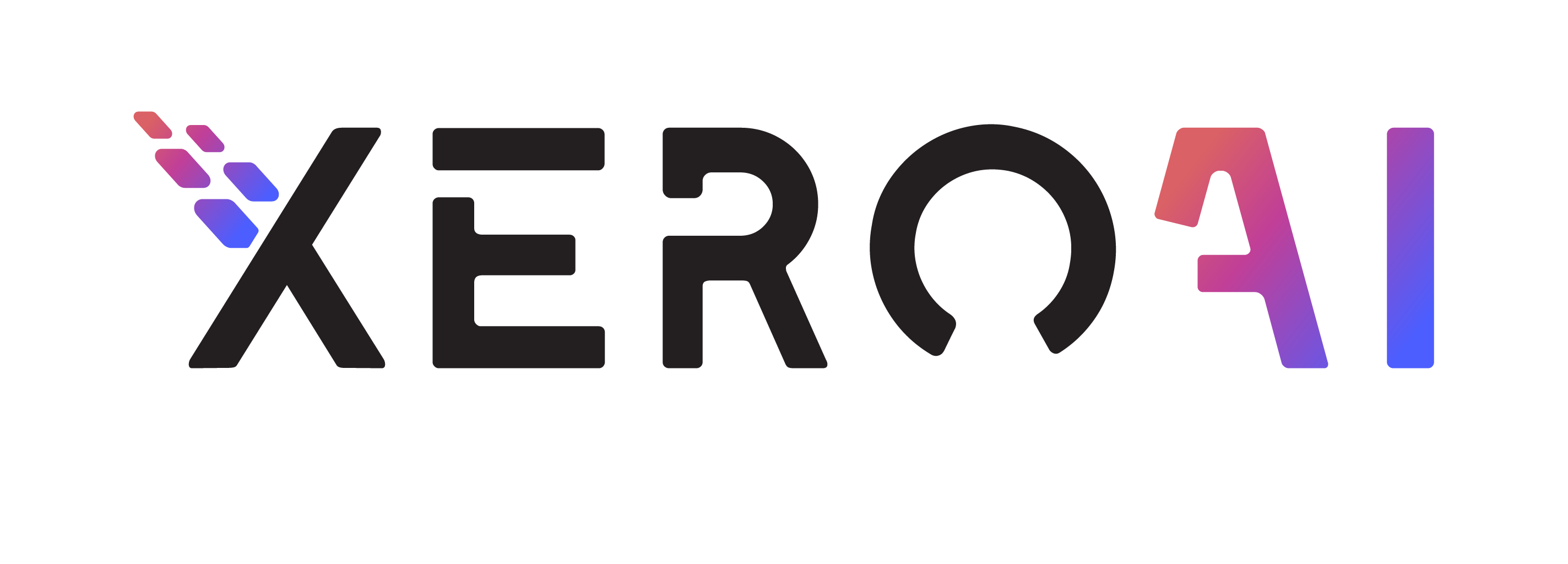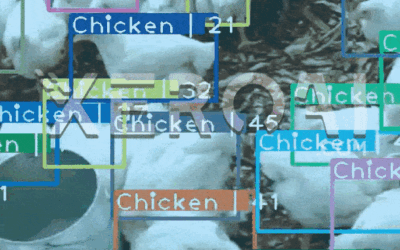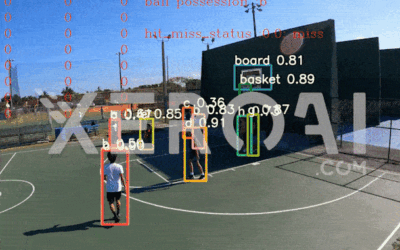1. Introduction
In the dynamic world of sports, data-driven insights have become a game-changer, revolutionizing the way teams and players analyze and improve their performance. Basketball, a fast-paced and strategic sport, has embraced the power of artificial intelligence (AI), computer vision, and deep learning to gain a competitive edge. In this blog, we will explore how these advanced technologies are transforming basketball player and team analysis. From recognizing player actions to evaluating team strategies, AI-driven sports analysis is reshaping the future of basketball.
Benefits of Basketball Analysis Using AI
The benefits of basketball analysis using computer vision and deep learning become even more important when considering the cost-effective and versatile nature of camera-based systems compared to sensor-based solutions. Here’s how adopting computer vision can revolutionize basketball analysis and offer substantial advantages:
Cost-Efficiency: Unlike sensor-based systems that require expensive equipment and sensors attached to each player, computer vision relies on standard cameras, making it a more cost-effective solution. This affordability is particularly advantageous for schools, colleges, and smaller basketball programs with limited budgets.
Scalability: Computer vision systems can be easily scaled to accommodate different court sizes and configurations. Whether it’s an indoor arena, a local gym, or an outdoor court, a few strategically placed cameras can cover the entire playing area, providing comprehensive analysis without the need for extensive sensor installations.
Minimal Intrusiveness: Players can perform at their best without the discomfort of wearing sensors or additional equipment. Computer vision operates discreetly, allowing athletes to focus solely on their game, which can lead to more authentic and representative performance data.
Versatility: In addition to real-time analysis, computer vision captures video footage of the entire game. These video clips are invaluable for later analysis and review, enabling coaches, players, and analysts to identify specific moments, player actions, and patterns that require attention. This retrospective analysis can uncover player weaknesses, team dynamics, and areas for improvement.
Action Clipping: With computer vision, it’s possible to create video clips of specific actions, such as a player’s jump shot or defensive maneuvers. These clips serve as powerful coaching tools for both immediate feedback during practice and in-depth post-game analysis. Coaches can provide visual evidence of areas where players excel or need improvement, making training more effective.
Objective Performance Metrics: Computer vision systems provide objective and quantifiable performance metrics, offering coaches and players an accurate assessment of their strengths and weaknesses. These metrics are based on visual data, eliminating subjective biases and ensuring fairness in player evaluations.
Enhanced Coaching: Coaches can leverage computer vision to gain deeper insights into player performance, team strategies, and game dynamics. This information empowers coaches to make data-driven decisions, devise better training regimens, and refine overall game strategies.
Player Development: Young and aspiring basketball players can benefit immensely from computer vision analysis. They can review their own gameplay, identify areas for improvement, and emulate successful techniques observed in professional games. This fosters skill development and nurtures the next generation of basketball talent.
Fan Engagement: Fans can enjoy a richer and more immersive basketball experience with computer vision-based analysis. Access to detailed statistics, video highlights, and real-time insights enhances their understanding and appreciation of the sport. This, in turn, deepens their connection with the teams and players they support.
Injury Prevention: Computer vision can assist in monitoring player movements and biomechanics, aiding in the identification of potential injury risks. Coaches and medical staff can intervene early to prevent injuries and promote player well-being.
Basketball analysis using computer vision and deep learning, especially when implemented through cost-effective camera-based systems, offers a multitude of benefits. It democratizes access to advanced performance analysis, enhances coaching and player development, and provides valuable retrospective insights through video clips. This technology not only elevates the sport but also makes basketball analysis more accessible, practical, and inclusive for players and teams at all levels.
3. What Are the Possible Use Cases
Computer vision opens up a vast array of use cases and aspects for analyzing basketball players, teams, and opposition teams. Here are different facets of the game that can be analyzed using computer vision:
Player Analysis:
Shooting Technique: Computer vision can assess a player’s shooting form, including shot angle, release time, and consistency. It can identify factors contributing to successful or missed shots.
Movement Patterns: Analyzing players’ movements on the court can reveal their agility, speed, and positioning. This can help coaches optimize strategies for offensive and defensive plays.
Dribbling Skills: Computer vision can track a player’s dribbling techniques, including ball-handling speed and dribble-to-shot transition times. It identifies weak spots and strengths in a player’s dribbling style.
Defensive Skills: Defensive maneuvers, such as blocking shots, intercepting passes, and guarding opponents, can be assessed. Coaches can identify defensive strengths and areas for improvement.
Player Communication: The technology can monitor player interactions, such as signaling plays, calling for passes, and coordinating defensive efforts, to evaluate teamwork and communication skills.
Team Analysis:
Game Strategy: Computer vision can uncover a team’s preferred game strategies, including offensive patterns (e.g., pick-and-roll, fast breaks) and defensive formations (e.g., zone defense, man-to-man coverage).
Ball Movement: Tracking the movement of the ball can provide insights into passing accuracy, ball possession time, and ball distribution among team members.
Player Coordination: By analyzing player movements and interactions, computer vision can evaluate how well a team coordinates on the court, such as creating scoring opportunities or executing set plays.
Offensive and Defensive Efficiency: The technology can assess a team’s offensive and defensive efficiency by analyzing factors like shot success rates, turnover rates, and fast break effectiveness.
Transition Play: Teams’ abilities in transition play (switching between offense and defense) can be analyzed, helping coaches optimize strategies during these critical moments.
Opposition Team Analysis:
Player Profiling: Computer vision can identify key players on the opposing team, monitoring their movements and actions. This helps teams strategize on how to defend against or exploit specific players.
Scouting Reports: Coaches can use computer vision to create detailed scouting reports on opposing teams. This includes tendencies in play style, favorite plays, and weaknesses to exploit.
Defensive Schemes: Analyzing the opposition’s defensive schemes and rotations can help teams identify areas where they can break through or find open shot opportunities.
Offensive Weaknesses: Identifying the opposition’s offensive weaknesses, such as poor ball handling or turnovers, can guide defensive strategies and create opportunities for steals and fast breaks.
Player Fatigue: Monitoring the opposition team’s player fatigue levels throughout the game can provide insights into when to apply pressure and exploit tired opponents.
Shot Selection: Computer vision can analyze the opposition’s shot selection, revealing their preferred shooting spots on the court and areas where they are less accurate.
In-Game Adjustments: By continuously analyzing the opposition’s actions in real-time, coaches can make dynamic adjustments to their team’s strategy during the game.
These use cases and aspects demonstrate how computer vision can be a game-changing tool for basketball analysis. It not only enhances player performance and development but also helps teams gain a competitive edge by making data-driven decisions and strategizing effectively against their opponents.
4. Data Collection and Preprocessing
Before diving into the world of AI-driven analysis, comprehensive data collection and preprocessing are essential. This phase involves gathering video footage of games and practices, ensuring high-quality recordings, and synchronizing data with video frames. Additionally, player and team data, such as player profiles, game statistics, and team strategies, must be organized for analysis. Training Data collection and preprocessing are crucial steps in basketball analysis using computer vision. The quality and reliability of the data collected directly impact the accuracy and effectiveness of the analysis. Camera placement plays a pivotal role in this process, and several considerations should be taken into account:
Court Coverage vs. Audience: The placement of cameras should ensure that they capture the basketball court’s entirety while minimizing the inclusion of the audience. Cameras covering more than just the court may lead to false detections of individuals in the audience, which can interfere with player tracking and analysis.
Distance from the Court: Cameras should be strategically positioned to achieve an optimal balance between court coverage and proximity to the action. Placing cameras too far from the court can result in reduced tracking accuracy and difficulty recognizing players’ faces and actions. The system may fail to capture critical player movements and interactions.
Bird’s Eye View: Avoiding a bird’s eye view perspective is crucial for player identification. Such an angle makes it extremely challenging to differentiate between players, as their distinguishing features are less visible. Side or slightly elevated views are often preferred for accurate recognition.
High-Resolution Cameras: The use of high-resolution cameras is essential for capturing fine details, such as player facial expressions, jersey numbers, and ball movement. Higher resolution enables more precise tracking and recognition.
Camera Angles: Multiple cameras may be strategically placed around the court to capture different angles and perspectives. This facilitates comprehensive player tracking and provides a more complete picture of the game. Wide-angle and close-up shots can be combined for a holistic view.
Camera Stability: Camera stability is crucial to prevent image blurring and ensure consistent tracking. Vibrations or shaky footage can result in tracking errors and make it challenging to analyze player movements accurately.
Lighting Conditions: Adequate lighting is necessary for clear and well-defined images. Poor lighting conditions can lead to shadowing, glare, or low contrast, making it difficult for the system to identify players and the ball.
Camera Calibration: Cameras should be calibrated to ensure accurate measurement of player positions and distances. Proper calibration accounts for lens distortion and perspective, improving the system’s tracking accuracy.
Data Synchronization: When multiple cameras are used, precise synchronization of their footage is essential. Accurate timestamps and synchronized frames ensure that events are correctly matched across different camera angles.
Noise Reduction: Preprocessing steps, such as noise reduction and background subtraction, help eliminate unwanted elements from the footage, such as moving spectators or artifacts, improving the system’s ability to focus on players and the ball.
By carefully addressing these considerations in camera placement, data collection, and preprocessing, basketball analysis systems can enhance their accuracy, reliability, and usefulness for player and team evaluation.
5. Different AI Models
Object detection
To perform detailed analysis, AI models are trained for various tasks:
Ball Detection: Identifying the basketball’s location and trajectory throughout the game.
Player Detection: Recognizing individual players on the court, including their movements and positions.
Basket and Board Detection: Locating the basketball hoop and backboard for shot analysis.
There are different state-of-the-art Deep learning model are availble such as:
YOLO (You Only Look Once): YOLO is a real-time object detection algorithm known for its speed and accuracy. YOLO models, including YOLOv3 and YOLOv4, can be trained to detect multiple objects simultaneously, making them suitable for identifying players, the ball, baskets, and boards.
Faster R-CNN: Faster R-CNN is a popular model for object detection. It combines a Region Proposal Network (RPN) with a convolutional neural network (CNN) for accurate object localization and classification. Faster R-CNN can be adapted for basketball object detection.
SSD (Single Shot MultiBox Detector): SSD is another real-time object detection model that provides a balance between speed and accuracy. It’s well-suited for tracking fast-moving objects like basketballs.
Object Tracking and Re-identification Models
Detection of player will only provide the localization information, however, we need to track and identify the player to maintain all the analysis related information.
SORT (Simple Online and Realtime Tracking): SORT is a tracking algorithm that can be combined with object detection models. It helps maintain consistent identities for players and the ball across frames, enabling tracking of their movements throughout the game.
DeepSORT: An extension of SORT, DeepSORT incorporates deep appearance features for more robust object re-identification. It’s particularly useful in scenarios where players may temporarily leave the camera frame.
6. Recognition of Actions
Once detection is in place, AI models can recognize and track player actions:
Throw of Ball at the Basket: Counting the number of attempts players make at the basket.
Successful Hits: Identifying successful shots made by players.
Misses: Recognizing when a shot does not go in a basket.
Passes to Teammates: Tracking successful and failed passes between players.
Snatches: Determining when a player steals the ball from the pass of the opponent team players..
Player Contributions in Points: Calculating the points scored by each player based on successful shots.
Additional Actions: AI can also extract data on player movements, dribbling, defensive plays, and more.
7. Conclusion
The combination of AI, computer vision, and deep learning in basketball player and team analysis has ushered in a new era of sports performance evaluation. From tracking player actions to evaluating team strategies, AI provides a level of precision and objectivity that was previously unimaginable. As technology continues to advance, basketball analysis using AI will become an integral part of player development, game strategy, and overall team success. With AI as a teammate, the sky’s the limit for basketball’s future.



